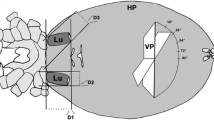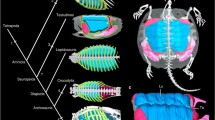Abstract
All known species of the Triassic archosauromorph genus Tanystropheus are known to have had the longest neck in proportion to their torso. This feature is related to a series of ventilatory challenges since an increase in neck length also increases airway length and, therefore, the volume of stagnant air that does not reach the lungs, the dead space volume. Based on this challenge, the objective of the present study was to model the type of respiratory system of Tanystropheus able to meet its metabolic demands during the early Triassic period. The modeling was based on allometric relations for morphological and physiological ventilatory and metabolic variables, and to do so, the mean body mass of Tanystropheus was estimated based on three different methods. In addition, the tracheal airflow was also estimated based on the proportions of Tanystropheus elongated neck, the results of allometric modeling, and fundamental equations of fluid mechanics. The estimation of the body mass indicated that an animal of 3.6 m would possess a body mass of 50.6 ± 21.6 kg. Allometric modeling suggested that the respiratory system best suited to Tanystropheus’ oxygen demands, especially during activity, would be a generic reptilian-like respiratory system composed of multicameral lungs. The best respiratory pattern to maintain adequate tracheal flow rates and effective pulmonary ventilation would be one ventilating the relatively narrower trachea at lower frequencies to deal with tracheal dead space volume.





Similar content being viewed by others
References
Albuquerque RL, Garland T (2020) Phylogenetic analysis of maximal oxygen consumption during exercise (V̇O2 max) and ecological correlates among lizard species. J Exp Biol jeb 229013 https://doi.org/10.1242/jeb.229013
Berner RA (1999) Atmospheric oxygen over Phanerozoic time. Proc Natl Acad Sci U S A 96:10955–10957. https://doi.org/10.1073/pnas.96.20.10955
Bishop CM (1999) The maximum oxygen consumption and aerobic scope of birds and mammals: getting to the heart of the matter. Proc R Soc B Biol Sci 266:2275–2281. https://doi.org/10.1098/rspb.1999.0919
Campione NE, Evans DC (2020) The accuracy and precision of body mass estimation in non-avian dinosaurs. Biol Rev 1761:1759–1797. https://doi.org/10.1111/brv.12638
Cieri RL, Farmer CG (2016) Unidirectional pulmonary airflow in vertebrates: a review of structure, function, and evolution. J Comp Physiol B 186:541–552. https://doi.org/10.1007/s00360-016-0983-3
de Souza RBB, Bonfim VMG, Passos VR, Klein W (2021) Allometric relations of respiratory variables in Amniota: effects of phylogeny, form, and function. Comp Biochem Physiol Part A 252:1–10. https://doi.org/10.1016/j.cbpa.2020.110845
Dlugosz EM, Chappell MA, Meek TH et al (2013) Phylogenetic analysis of mammalian maximal oxygen consumption during exercise. J Exp Biol 216:4712–4721. https://doi.org/10.1242/jeb.088914
Evju Ø, Mardal KA (2015) On the assumption of laminar flow in physiological flows: cerebral aneurysms as an illustrative example. In: Modeling the Heart and the Circulatory System 177–195
Ezcurra MD (2016) The phylogenetic relationships of basal archosauromorphs, with an emphasis on the systematics of proterosuchian archosauriforms. PeerJ 2016:1–385. https://doi.org/10.7717/peerj.1778
Feldman A, Meiri S (2013) Length–mass allometry in snakes. Biol J Linn Soc 108:161–172
Frappell PB, Hinds DS, Boggs DF (2001) Scaling of respiratory variables and the breathing pattern in birds: an allometric and phylogenetic approach. Physiol Biochem Zool 74:75–89. https://doi.org/10.1086/319300
Grigg GC, Seebacher F, Beard LA, Morris D (1998) Thermal relations of large crocodiles, Crocodylus porosus, free-ranging in a naturalistic situation. Proc R Soc B Biol Sci 265:1793–1799. https://doi.org/10.1098/rspb.1998.0504
Henderson DM (2004) Tipsy punters: sauropod dinosaur pneumaticity, buoyancy and aquatic habits. Proc R Soc B Biol Sci 271:180–183. https://doi.org/10.1098/rsbl.2003.0136
Hinds DS, Calder WA (1971) Tracheal dead space in the respiration of birds. Evolution (n y) 25:429–440
Hughes GM, Gaymer R, Moore M, Woakes AJ (1971) Respiratory exchange and body size in the Aldabra giant tortoise. J Exp Biol 55:651–665
Hugh-Jones P, Barter CE, Hime JM, Rusbridge MM (1978) Dead space and tidal volume of the giraffe compared with some other mammals. Respir Physiol 35:53–58. https://doi.org/10.1016/0034-5687(78)90040-3
Hurlburt G (1999) Comparison of body mass estimation techniques, using recent reptiles and the pelycosaur Edaphosaurus boanerges. J Vertebr Paleontol 19:338–350
Jessop TS, Madsen T, Sumner J, Rudiharto H, Phillips JA, Ciofiet C (2006) Maximum body size among insular Komodo dragon populations covaries with large prey density. Oikos 112:422–429. https://doi.org/10.1111/j.0030-1299.2006.14371.x
Lambertz M, Grommes K, Kohlsdorf T, Perry SF (2015) Lungs of the first amniotes: why simple if they can be complex? Biol Lett 11:1–5. https://doi.org/10.1098/rsbl.2014.0848
Lambertz M, Shelton CD, Spindler F, Perry SF (2016) A caseian point for the evolution of a diaphragm homologue among the earliest synapsids. Ann N Y Acad Sci 1385:3–20. https://doi.org/10.1111/nyas.13264
Meyer H (1852) Die Saurier des Muschelkalkes: mit Rücksicht auf die Saurier aus Buntem Sandstein und Keuper. In: Zur Fauna der Vorwelt. Heinrich Keller, Frankfurt am Main
Meiri S (2010) Length weight allometries in lizards. J Zool 281:218–226. https://doi.org/10.1111/j.1469-7998.2010.00696.x
Miller CS, Baranyi V (2021) Triassic Climates. Encycl Geol 2:514–524. https://doi.org/10.1016/b978-0-12-409548-9.12070-6
Milsom WK (1988) Control of arrhythmic breathing in aerial breathers. Can J Zool 66:99–108. https://doi.org/10.1139/z88-014
Noè LF, Taylor MA, Gómez-Pérez M (2017) An integrated approach to understanding the role of the long neck in plesiosaurs. Acta Palaeontol Pol 62:137–162. https://doi.org/10.4202/app.00334.2016
Norberg UM (1996) Energetics of Flight. In: Carey C (ed) Avian nergetics and Nutritional Ecology. Chapman & Hall, pp 199–249
Nosotti S (2007) Tanystropheus longobardicus (Reptilia, Protorosauria): Re-interpretations of the anatomy based on new specimens from the middle Triassic of Besano (Lombardy, Northen Italy). Mem Della Soc Ital Di Sci Nat e Del Mus Civ Di Stor Nat Di Milano 35:1–88
Otis AB (1964) Quantitative relationships in steady-state gas exchange. Handb Physiol Respir 681–698
Perry SF (1998) Lungs: comparative anatomy, functional morphology, and evolution. In: Gans C, Gaunt AS (eds) Biology of Reptilia, vol 19. Morphology G. Society for the Study of Amphibians and Reptiles, Ithaca, pp 1–93
Perry SF, Christian A, Breuer T et al (2009) Implications of an avian-style respiratory system for gigantism in sauropod dinosaurs. J Exp Zool Part A Ecol Genet Physiol 311:600–610. https://doi.org/10.1002/jez.517
Renesto S (2005) A new specimen of Tanystropheus (Reptilia Protorosauria) from the Middle Triassic of Switzerland and the ecology of the genus. Riv Ital di Paleontol e Stratigr 111:377–394. https://doi.org/10.13130/2039-4942/6327
Renesto S, Saller F (2018) Evidences for a semi aquatic life style in the triassic diapsid reptile Tanystropheus. Riv Ital di Paleontol e Stratigr 124:23–34. https://doi.org/10.13130/2039-4942/9541
Schachner ER, Hedrick BP, Richbourg HA, et al (2020) Anatomy, ontogeny, and evolution of the archosaurian respiratory system: A case study on Alligator mississippiensis and Struthio camelus. J Anat 1–29 https://doi.org/10.1111/joa.13358
Spiekman SNF, Neenan JM, Fraser NC et al (2020) Aquatic habits and niche partitioning in the extraordinarily long-necked triassic reptile tanystropheus. Curr Biol 30:1–7. https://doi.org/10.1016/j.cub.2020.07.025
Stahl WR (1967) Scaling of respiratory variables in mammals. J Appl Physiol 22:453–460. https://doi.org/10.1152/jappl.1967.22.3.453
Stuginski DR, Navas CA, de Barros FC et al (2018) Phylogenetic analysis of standard metabolic rate of snakes: a new proposal for the understanding of interspecific variation in feeding behavior. J Comp Physiol B Biochem Syst Environ Physiol 188:315–323. https://doi.org/10.1007/s00360-017-1128-z
Taylor MP, Wedel MJ (2013) Why sauropods had long necks; and why giraffes have short necks. PeerJ 2013:1–41. https://doi.org/10.7717/peerj.36
Taylor RC, Maloiy GMO, Weibel ER et al (1981) Design of the mammalian respiratory system. III. Scaling maximum aerobic capacity to body mass: Wild and domestic mammals. Respir Physiol 44:25–37. https://doi.org/10.1016/0034-5687(81)90075-X
Tenney SM, Bartlett D (1967) Comparative quantitative morphology of the mammalian lung: trachea. Respir Physiol 3:130–135. https://doi.org/10.1016/0034-5687(67)90002-3
Wang T, Abe AS, Glass ML (1998) Temperature effects on lung and blood gases in Bufo paracnemis: consequences of bimodal gas exchange. Respir Physiol 113:231–238. https://doi.org/10.1016/S0034-5687(98)00066-8
Weibel ER, Bacigalupe LD, Schmitt B, Hoppeler H (2004) Allometric scaling of maximal metabolic rate in mammals: muscle aerobic capacity as determinant factor. Respir Physiol Neurobiol 140:115–132. https://doi.org/10.1016/j.resp.2004.01.006
Acknowledgements
We thank Dr. Christian Klug from the Paleontological Museum of the University of Zürich for providing the photographs of the Tanystropheus specimen used as our model and Dra. Silvana Giuliatti from the University of São Paulo for helping us understand some physical principles regarding our study. We also would like to thank the three reviewers for carefully reading and improving our work with their suggestions.
Funding
WK received funding from the Conselho Nacional de Desenvolvimento Científico e Tecnológico (CNPq; process no. 308249/2019–4) and RBBS was supported by Fundação de Amparo à Pesquisa do Estado de São Paulo (FAPESP; process no. 2018/21117–7).
Author information
Authors and Affiliations
Corresponding author
Additional information
Communicated by: Robert R Reisz
Publisher's note
Springer Nature remains neutral with regard to jurisdictional claims in published maps and institutional affiliations.
Supplementary Information
Below is the link to the electronic supplementary material.
Rights and permissions
Springer Nature or its licensor (e.g. a society or other partner) holds exclusive rights to this article under a publishing agreement with the author(s) or other rightsholder(s); author self-archiving of the accepted manuscript version of this article is solely governed by the terms of such publishing agreement and applicable law.
About this article
Cite this article
de Souza, R.B.B., Klein, W. Modeling of the respiratory system of the long-necked Triassic reptile Tanystropheus (Archosauromorpha). Sci Nat 109, 55 (2022). https://doi.org/10.1007/s00114-022-01824-7
Received:
Revised:
Accepted:
Published:
DOI: https://doi.org/10.1007/s00114-022-01824-7




